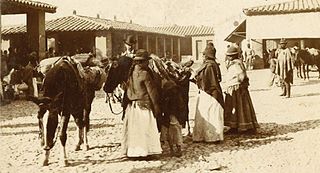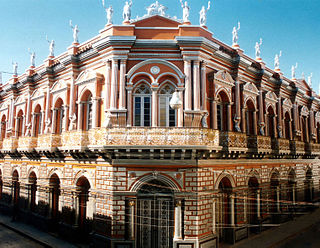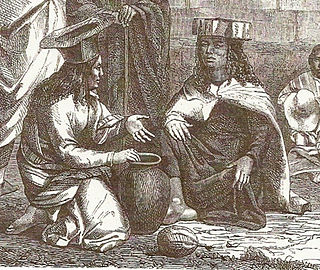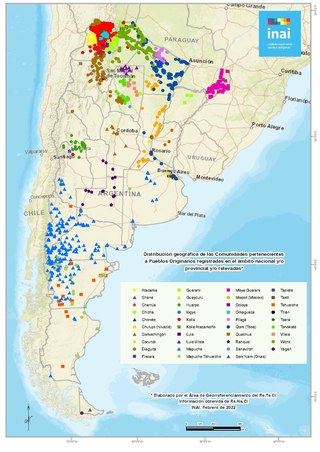History
The Qulla have lived in their region for centuries. Sillustani is a prehistoric Qulla cemetery in Peru, with elaborate stone chullpas . Several groups made up the Qulla people, including the Zenta, and Gispira. The Qulla came into contact with Spaniards in 1540. They resisted the Spanish invasion for many years but ultimately failed and the Santiago Estate fell into Spanish hands. One particularly famous rebel leader was Ñusta Willaq, a female warrior who fought the Spanish in 1780. With Argentinian independence in 1810, the situation of the Qulla people did not improve and they worked for minimal wages.
On 31 August 1945, Qulla communities in the northwestern Argentine provinces of Jujuy and Salta, through a group of representatives, sent a note to the National Agrarian Council demanding the restitution of their lands, in compliance with previous laws. On 17 January 1946 President Edelmiro Julián Farrell signed the expropriation decree. But as funds for the necessary land surveys and paperwork were in progress, the direction of the Council passed to other people, who blocked them. In 1946, Qulla people joined the Malón de la Paz, a march to the capital of Buenos Aires to demand the return of their lands.
In the 1950s, Qulla people worked in the timber industry on their ancestral lands. [1]
In 1985, the Argentinian government officially recognized the indigenous peoples of that country by Law 23303. [1] A cholera epidemic took a toll on the Qulla population in the late 20th century. [6] In August 1996, many Qulla people occupied and blocked roads to their traditional lands but were violently stopped by the police. On 19 March 1997, the Qulla people finally regained legal possession of the Santiago Estate. [1]
Today
In the Province of Salta, Northern Argentina, Qullamarka is the Coordinating Platform for five different Qulla organizations, including the Kolla Tinkunaku Community is a grassroots organization, which represents four Qulla communities. Two other organizations represent Qulla rights in Argentina: Centro Kolla in Buenos Aires and the Indianista de los Pueblos Kollas. Because they traditionally held their land in common, the Qulla do not have titles of ownership to their lands, which has resulted in displacement. However, the Qulla participate in Argentinian government and hold local elected positions in their region.
The Additional Survey on Indigenous Populations, published by the National Institute for Statistics and Census, gives a total of 600,329 people out of some 40 million in Argentina who see themselves as descending from or belonging to an indigenous people.
For a number of reasons the different indigenous organisations do not believe this to be a credible survey. Firstly, the methodology used in the survey was considered inadequate, as a large number of indigenous people live in urban areas, where the survey was not fully conducted. Second, many indigenous people in the country hide their identity for fear of discrimination. Moreover, when the survey was designed in 2001, it was based on the existence of 18 known peoples in the country, but now, there exist more than 31 groups. That increase reflects a growing awareness amongst indigenous people in terms of their ethnic belonging.
As many Argentinians believe that the majority of the indigenous have died out or are on the verge of doing or that their descendants have assimilated into Western civilisation many years ago, they hold the idea that there are no indigenous people in their country. The use of pejorative terms likening the indigenous to lazy, idle, dirty, ignorant and savage are part of the everyday language in Argentina. Those stereotypes have forced many indigenous people, over the years, to hide their identity to avoid racial discrimination.

Quechua, also called Runasimi in Southern Quechua, is an indigenous language family that originated in central Peru and thereafter spread to other countries of the Andes. Derived from a common ancestral "Proto-Quechua" language, it is today the most widely spoken pre-Columbian language family of the Americas, with the number of speakers estimated at 8–10 million speakers in 2004, and just under 7 million from the most recent census data available up to 2011. Approximately 13.9% of Peruvians speak a Quechua language.

The Aymara or Aimara, people are an indigenous people in the Andes and Altiplano regions of South America; about 2.3 million live in northwest Argentina, Bolivia, Chile, and Peru. Their ancestors lived in the region for many centuries before becoming a subject people of the Inca in the late 15th or early 16th century, and later of the Spanish in the 16th century. With the Spanish-American wars of independence (1810–1825), the Aymaras became subjects of the new nations of Bolivia and Peru. After the War of the Pacific (1879–1883), Chile annexed territory with the Aymara population.

Jujuy is a province of Argentina, located in the extreme northwest of the country, at the borders with Chile and Bolivia. The only neighboring Argentine province is Salta to the east and south.

Salta is a province of Argentina, located in the northwest of the country. Neighboring provinces are from the east clockwise Formosa, Chaco, Santiago del Estero, Tucumán and Catamarca. It also surrounds Jujuy. To the north it borders Bolivia and Paraguay and to the west lies Chile.

The Altiplano, Collao or Andean Plateau, in west-central South America, is the most extensive high plateau on Earth outside Tibet. The plateau is located at the latitude of the widest part of the north–south-trending Andes. The bulk of the Altiplano lies in Bolivia, but its northern parts lie in Peru, and its southwestern fringes lie in Chile.

Tarija or San Bernardo de la Frontera de Tarixa is a city in southern Bolivia. Founded in 1574, Tarija is the largest city and capital and municipality within the Tarija Department, with an airport offering regular service to primary Bolivian cities, as well as a regional bus terminal with domestic and international connections. Its climate is semi-arid (BSh) with generally mild temperatures in contrast to the harsh cold of the Altiplano and the year-round humid heat of the Amazon Basin. Tarija has a population of 234,442.

Quechua people or Quichua people may refer to any of the indigenous peoples of South America who speak the Quechua languages, which originated among the Indigenous people of Peru. Although most Quechua speakers are native to Peru, there are some significant populations in Ecuador, Bolivia, Chile, Colombia, and Argentina.

The Wichí are an indigenous people of South America. They are a large group of tribes ranging about the headwaters of the Bermejo River and the Pilcomayo River, in Argentina and Bolivia.
Departments form the second level of administrative division, and are subdivided in municipalities. They are extended in all of Argentina except for the Province of Buenos Aires and the Autonomous City of Buenos Aires, the national capital, each of which has different administrative arrangements.

South Bolivian Quechua, also known as Central Bolivian Quechua, is a dialect of Southern Quechua spoken in Bolivia and adjacent areas of Argentina, where it is also known as Colla. It is not to be confused with North Bolivian Quechua, which is spoken on the northern Andean slopes of Bolivia and is phonologically distinct from the South Bolivian variety. Estimates of the number of speakers of South Bolivian Quechua range from 2.3 to 2.8 million, making it the most spoken indigenous language in Bolivia, just slightly greater than Aymara, with roughly 2 million speakers in Bolivia. In comparison, the North Bolivian dialect has roughly 116,000 speakers.

The Malón de la Paz was a march of indigenous peoples of northwestern Argentina to the capital, Buenos Aires, demanding the restitution of their ancient lands, in 1946. The participants marched about 2,000 km to present their claims to President Juan Perón.

Southern Quechua, or simply Quechua, is the most widely spoken of the major regional groupings of mutually intelligible dialects within the Quechua language family, with about 6.9 million speakers. It is also the most widely spoken indigenous language in the Americas. The term Southern Quechua refers to the Quechuan varieties spoken in regions of the Andes south of a line roughly east–west between the cities of Huancayo and Huancavelica in central Peru. It includes the Quechua varieties spoken in the regions of Ayacucho, Cusco and Puno in Peru, in much of Bolivia and parts of north-west Argentina. The most widely spoken varieties are Cusco, Ayacucho, Puno (Collao), and South Bolivian.

Spanish is the language that is predominantly understood and spoken as a first or second language by nearly all of the population of Argentina. According to the latest estimations, the population is currently greater than 45 million.

Santiago del Estero Quichua or Santiagueño Quechua is a vulnerable dialect of Southern Quechua spoken by 60,000-100,000 people in Argentina. It is spoken in the province of Santiago del Estero. The estimated coordinates are 27°47′S 64°16′W. Long-standing migration has also resulted in the presence of the language in other provinces of northeastern Argentina and in Buenos Aires.
Eastern Bolivian Guaraní, known locally as Chawuncu or Chiriguano (pejorative), is a Guaraní language spoken in South America. In Bolivia 33,670 speakers, called the Ava Guaraní people were counted in the year 2000, in the south-central Parapeti River area and in the city of Tarija. In Argentina, there were approximately 15,000 speakers, mostly in Jujuy, but also in Salta Province, and 304 counted in the Paraguayan Chaco.

The Atacama people, also called Atacameño, are indigenous people from the Atacama Desert and altiplano region in the north of Chile and Argentina and southern Bolivia, mainly Antofagasta Region.

Argentina has 35 indigenous people groups officially recognized by the national government. As of the 2010 census [INDEC], some 955,032 Argentines self-identify as indigenous or first-generation descendants of indigenous peoples.

The aguayo, or also quepina is a rectangular carrying cloth used in traditional communities in the Andes region of Argentina, Bolivia, Chile, Colombia, Ecuador and Peru. Aymara and Quechua people use it to carry small children or various other items in it on their backs. It is similar to a lliklla and sometimes regarded as a synonym.

Indigenous peoples in Bolivia, or Native Bolivians, are Bolivian people who are of indigenous ancestry. They constitute anywhere from 20 to 60% of Bolivia's population of 11,306,341, depending on different estimates, and depending notably on the choice "Mestizo" being available as an answer in a given census, in which case the majority of the population identify as mestizo, and they belong to 36 recognized ethnic groups. Aymara and Quechua are the largest groups. The geography of Bolivia includes the Andes, the Gran Chaco, and the Amazon Rainforest.

















